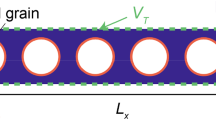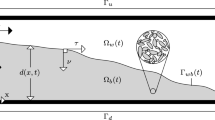Abstract
We demonstrate how a network model can predict porosity and permeability changes in a porous medium as a result of biofilm buildup in the pore spaces. A biofilm consists of bacteria and extracellular polymeric substances (EPS) bonded together and attached to a surface. In this case, the surface consists of the walls of the porous medium, which we model as a random network of pipes.
Our model contains five species. Four of these are bacteria and EPS in both fluid and adsorbed phases. The fifth species is nutrient, which we assume to reside in the fluid phase only. Bacteria and EPS transfer between the adsorbed and fluid phases through adsorption and erosion or sloughing. The adsorbed species influence the effective radii of the pipes in the network, which affect the porosity and permeability.
We develop a technique for integrating the coupled system of ordinary and partial differential equations that govern transport of these species in the network. We examine ensemble averages of simulations using different arrays of pipe radii having identical statistics. These averages show how different rate parameters in the biofilm transport processes affect the concentration and permeability profiles.
Similar content being viewed by others
References
Alexander, M.: 1994, Biodegradation and Bioremediation, Academic Press, New York.
Amy, P. S. and Haldeman, D. L. (eds): 1997, Chapter 17: Biofilm processes in porous media — practical applications, The Microbiology of the Terrestrial Deep Subsurface, CRC Press, Boca Raton.
Bakke, R., Trulear, M. G. and Characklis, W. G.: 1984, Activity of pseudomonsa aeruginosa in biofilms: steady-state, Biotechnol. Bioengi. 26, 1418–1424.
Characklis, W. G. and Marshall, K. C. (eds): 1990, Biofilms, Wiley, New York.
Escher, A. R.: 1986, Colonization of a smooth surface by Pseudomonas aeruginosa: Image analysis methods, PhD dissertation, Montana State University, Bozeman, MT.
Imdakm, A. O. and Sahimi, M.: 1991, Computer simulation of particle transport processes in flow through porous media, Chem. Eng. Sci. 46(8), 1977–1993.
Jerauld, G. R., Hatfield, J. C., Scriven, L. E. and Davis, H. T.: 1984a, Percolation and conduction on Voronoi and triangular networks: A case study in topological disorder, J. Phys. C: Solid State Phys. 17, 1519–1529.
Jerauld, G. R., Scriven, L. E. and Davis, H. T.: 1984b, Percolation and conduction on the 3D Voronoi and regular networks: A second case study in topological disorder, J. Phys. C: Solid State Phys. 17, 3429–3439.
Koplik, J.: 1982, Creeping flow in two-dimensional networks, J. Fluid Mech. 119, 219–247.
Lindqvist, R., Cho, J. S. and Enfield, C. G.: 1994, A kinetic model for cell density dependent bacterial transport in porous media, Water Resour. Res. 30(12), 3291–3299.
MacLeod, F. A., Lappin-Scott, H. M. and Costerton, J. W.: 1988, Plugging of a model rock system by using starved bacteria, Appl. Environ. Microbiol. 54(6), 1365–1372.
Melo, L. F., Bott, T. R., Fletcher, M. and Capdeville, B. (eds): 1992, Biofilms — Science and Technology, Kluwer Acad. Publ., Dordrecht.
Mitchell, R.: 1978, Water Pollution Microbiology, Volume 2, Wiley, New York.
Scheidegger, A. E.: 1957, The Physics of Flow Through Porous Media, University of Toronto Press.
Suchomel, B. J., Chen, B. M. and Allen, M. B.: 1998, Network model of flow, transport and biofilm effects in porous media, Transport in Porous Media 30(1), 1–23.
Taylor, S. W. and Jaffé, P. R.: 1990, Biofilm growth and the related changes in the physical properties of a porous medium 1. Experimental investigation, Water Resour. Res. 26(9), 2153–2159.
Vandevivere, P. and Baveye, P.: 1992a, Effect of bacterial extracellular polymers on the saturated hydraulic conductivity of sand columns, Appl. and Environ. Microbiol. 58(5), 1690–1698.
Vandevivere, P. and Baveye, P.: 1992b, Saturated hydraulic conductivity reduction caused by aerobic bacteria in sand columns, Soil Sci. Soc. Am. J. 56(1), 1–13.
Wanner, O. and Gujer, W.: 1986, A multispecies biofilm model, Biotechnol. Bioeng. 28, 314–328.
Author information
Authors and Affiliations
Rights and permissions
About this article
Cite this article
Suchomel, B.J., Chen, B.M. & Allen, M.B. Macroscale Properties of Porous Media from a Network Model of Biofilm Processes. Transport in Porous Media 31, 39–66 (1998). https://doi.org/10.1023/A:1006506104835
Issue Date:
DOI: https://doi.org/10.1023/A:1006506104835




